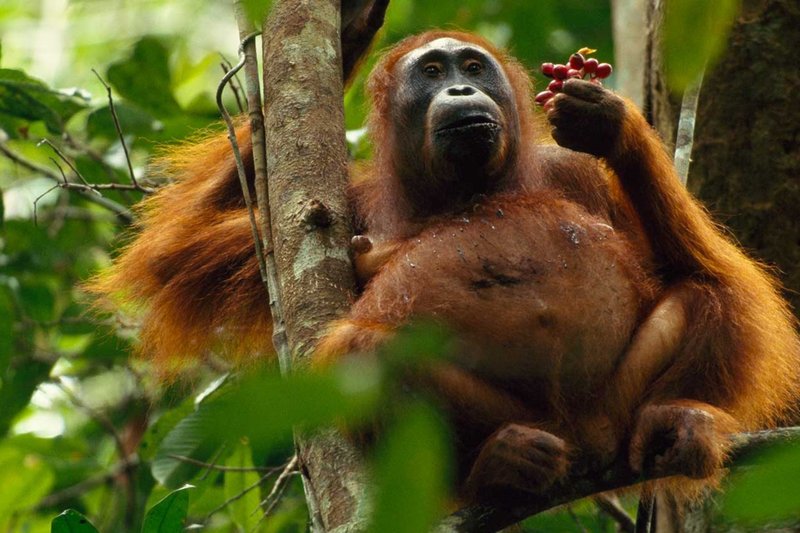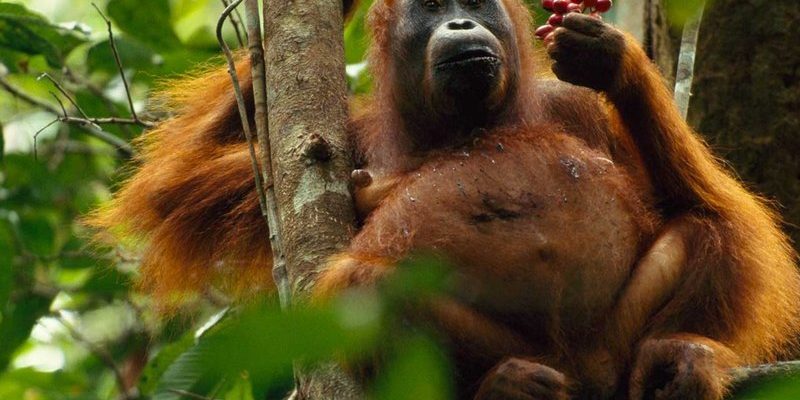
Imagine a chef in a restaurant, carefully selecting the freshest ingredients to create a gourmet dish. That’s a bit like what Sumatran orangutans do as they forage for food. They are not just passive eaters; they have specific strategies to hunt for their meals, relying on their keen sense of observation and skillful manipulation of their surroundings. Let’s dive deeper into the world of Sumatran orangutans to explore their diet and hunting strategies, and discover how these remarkable animals thrive in their lush habitat.
Understanding the Sumatran Orangutan’s Habitat
To appreciate the diet and hunting strategies of the Sumatran orangutan, we first need to understand where they live. These apes call the tropical rainforests of Sumatra their home. Think of these forests as a giant supermarket packed with all sorts of delicious fruits, nuts, and leaves. Unfortunately, due to deforestation and habitat loss, this “supermarket” is getting smaller every day, putting a lot of pressure on these incredible creatures.
Sumatran orangutans prefer the high canopies, where they can find easily accessible food sources. They’re perfectly designed for arboreal life, with long arms and strong grips that allow them to swing gracefully between branches. This habitat not only provides food but also keeps them safe from many predators. The tall trees act as a protective barrier, allowing them to forage for food while staying out of harm’s way.
The Primary Diet of Sumatran Orangutans
When it comes to food, Sumatran orangutans are primarily frugivorous, meaning they love to eat fruits. Fruits make up about 60% to 80% of their diet. Some of their favorites include durian, jackfruit, and various figs. Each meal is an adventure where they might have to climb, swing, and reach just to grab their favorite snacks.
In addition to fruits, orangutans also enjoy leaves, flowers, and the bark of certain trees. They’re opportunistic eaters, which means if they come across something tasty and nutritious, they won’t hesitate to munch on it. You might be wondering how they manage to find all this food. Well, orangutans have a keen sense of smell and are great at using their memory to locate fruit trees that bloom at different times of the year.
Here are some key food sources for Sumatran orangutans:
- Fruits: Durian, jackfruit, and figs
- Leaves: Young, tender leaves from various trees
- Flowers: Nutritious flowers that bloom seasonally
- Bark: The inner bark of certain trees
Hunting Techniques and Foraging Behavior
Now, let’s talk about how Sumatran orangutans hunt for their food. Unlike many predators that chase their meals, orangutans are more like skilled foragers. They use a combination of patience, intelligence, and physical prowess to find their next meal. Imagine going on a treasure hunt where you have to outsmart everything in your path; that’s how these orangutans approach their diet.
One of their key strategies is to observe and remember the locations of fruit trees. They often engage in what’s called “tree learning,” where they watch how other animals, like birds or monkeys, interact with certain trees. This observation helps them identify which trees will bear fruit soon. They might even return to the same tree multiple times to ensure they get the ripest fruit.
Another fascinating technique they use is what you might call “tool use.” While Sumatran orangutans aren’t as famous for tool use as their African cousins, they’ve been observed using sticks to extract insects or honey, making them more efficient hunters. This demonstrates their adaptability and intelligence as they innovate new ways to get the nutrition they need.
Seasonal Changes and Food Availability
The diet of Sumatran orangutans isn’t static; it changes throughout the year based on food availability. Just like us, they have favorite seasons! During fruiting seasons, when trees are full of luscious fruits, orangutans can feast to their hearts’ content. However, during leaner months, they may have to rely more on leaves and bark.
In a way, it’s like a buffet that’s constantly changing. Some trees produce fruit only during specific times, so the orangutans must adjust their foraging behavior accordingly. They may travel further or spend more time searching just to find enough to eat. This adaptability is crucial for their survival, especially as their habitats shrink due to human activities.
During these lean months, orangutans also show remarkable social behavior. They may come together to share food or help each other find hidden sources of nutrition. This social aspect is fascinating because it highlights the deep connections within their species, which is crucial for survival in challenging environments.
The Impact of Habitat Loss on Their Diet and Hunting
Unfortunately, the Sumatran orangutan’s diet and hunting strategies are increasingly threatened by habitat loss due to deforestation and illegal logging. Imagine trying to find your favorite restaurant, only to discover it’s been replaced by a parking lot. That’s a reality for these orangutans. As trees disappear, so do their food sources, making it harder to sustain themselves.
The loss of habitat not only reduces the availability of their natural food but also disrupts their hunting strategies. When forests are fragmented, orangutans may have to travel longer distances to find food, increasing their risk of encounters with humans or other dangers. This added stress can affect their overall health and well-being.
Conservation efforts are vital to protect these magnificent creatures and their habitats. By advocating for sustainable practices and reforestation, we can help ensure that Sumatran orangutans continue to have access to their beloved foods and the lush canopy they call home.
Conservation Efforts and the Future of Sumatran Orangutans
So, what can be done to help the Sumatran orangutan? Conservation organizations are making strides in protecting their habitats and raising awareness about the importance of these incredible creatures. Much like how we might band together to support a friend in need, conservation efforts require collective action.
Initiatives include creating wildlife corridors so orangutans can safely navigate between fragmented habitats. These corridors act like bridges, ensuring they can reach food sources without having to cross dangerous areas. Additionally, educating local communities about the importance of sustainable practices can help protect the forests that orangutans depend on.
You might be surprised to learn that even small actions can help. Supporting sustainable products, like palm oil certified by organizations that protect wildlife habitats, can make a real difference. Every little effort counts when it comes to conserving the future of Sumatran orangutans.
In conclusion, the diet and hunting strategies of the Sumatran orangutan are a testament to their resilience and adaptability. By understanding their unique feeding habits and the challenges they face, we can appreciate these amazing creatures even more. Together, we can work towards a future where orangutans can thrive in their natural homes, enjoying their favorite fruits and living out their lives in the treetops. Let’s continue to listen to their story and make choices that support their survival.

